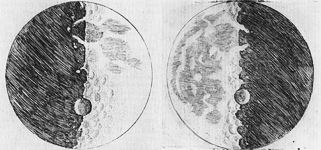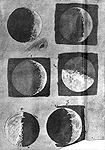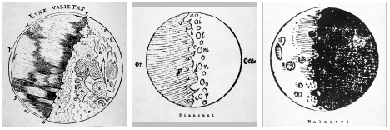
 |
| The Moon in Sidereus Nuncius |
The Moon
Ignoring the occasional pre-telescopic appearance of exceptionally large sunspots, the Moon is the only heavenly body which shows features to the naked eye--the Man in the Moon. These features are permanent, and it was therefore obvious that the Moon always keeps its same face turned to us (although there are minor perturbations that were not noticed until later). In the philosophy of Aristotle (384-322 BCE), these features presented somewhat of a problem. The heavens, starting at the Moon, were the realm of perfection, the sublunary region was the realm of change and corruption, and any resemblance between these regions was strictly ruled out. Aristotle himself suggested that the Moon partook perhaps of some contamination from the realm of corruption.
Although Aristotle's natural philosophy was very influential in the Greek world, it was not without competitors and skeptics. Thus, in his little book On the Face in the Moon's Orb, the Greek writer Plutarch (46-120 CE) expressed rather different views on the relationship between the Moon and Earth. He suggested that the Moon had deep recesses in which the light of the Sun did not reach and that the spots are nothing but the shadows of rivers or deep chasms. He also entertained the possibility that the Moon was inhabited. In the following century, the Greek satirist Lucian (120-180 CE) wrote of an imaginary trip to the Moon, which was inhabited, as were the Sun and Venus.
The medieval followers of Aristotle, first in the Islamic world and then in Christian Europe, tried to make sense of the lunar spots in Aristotelian terms. Various possibilities were entertained. It had been suggested already in Antiquity that the Moon was a perfect mirror and that its markings were reflections of earthly features, but this explanation was easily dismissed because the face of the Moon never changes as it moves about the Earth. Perhaps there were vapors between the Sun and the Moon, so that the images were actually contained in the Sun's incident light and thus reflected to the Earth. The explanation that finally became standard was that there were variations of "density" in the Moon that caused this otherwise perfectly spherical body to appear the way it does. The perfection of the Moon, and therefore the heavens, was thus preserved.
It is a curious fact that although many symbolic images of the Moon survive in medieval and Renaissance works of art (usually a crescent), virtually no one bothered to represent the Moon with its spots the way it actually appeared. We only have a few rough sketches in the notebooks of Leonardo da Vinci (ca. 1500) and a drawing of the naked-eye moon by the English physician William Gilbert. None of these drawings found its way into print until well after the telescope had come into astronomy.
The telescope delivered the coup de grace to attempts to explain away the Moon's spots and to the perfection of the heavens in general. With his telescope, Galileo saw not only the "ancient" spots, but many smaller ones never seen before. In these smaller spots, he saw that the width of the dark lines defining them varied with the angle of solar illumination. He watched the dark lines change and he saw light spots in the unilluminated part of the Moon that gradually merged with the illuminated part as this part grew. The conclusion he drew was that the changing dark lines were shadows and that the lunar surface has mountains and valleys. The Moon was thus not spherical and hardly perfect.
 |
| Galileo's wash drawings |
Galileo was not the only observer of the Moon. Indeed, he was not the first. Thomas Harriot drew the first telescopic representation of the Moon and observed our nearest neighbor for several years. His drawings, however, remained unpublished.
Those who wished to defend the perfection of the heavens brought out the old argument about rarity and density. In the letter of the Collegio Romano mathematicians to Cardinal Bellarmine of April 1611, Christoph Clavius (74 years old) expressed a minority opinion: "But it appears to Father Clavius more probable that the surface is not uneven, but rather that the lunar body is not of uniform density and has denser and rarer parts, as are the ordinary spots seen with the natural sight."[1] The other three Jesuit mathematicians on the faculty of the college, however, believed that the lunar surface was indeed uneven. In this case the opposition faded away over the next few years.
Galileo wrote in a letter, 1610, that he would like to make a series of representations of the Moon showing its changing phases. Presumably his purpose was to show how the shadows of individual features changed with the illumination. It appears that he abandoned this plan when he saw that there was no need for such an ambitious and expensive project: even the Jesuit fathers in Rome were convinced that the Moon's surface was uneven. Indeed, Galileo never returned to the task of representing the Moon. (In the 1630s he did, however, observe lunar librations, which show that the Moon does not always keep exactly the same face turned toward the Earth.) Others did little better. Thomas Harriot did make a rough map of the full Moon but never published it. Representations by Christoph Scheiner, Giuseppe Biancani, and Charles Malapert were little more than diagrams, useful only for supporting the verbal argument that the Moon's surface is rough and uneven. These were, so to speak, generic moons, not portraits of our nearest neighbor.

|
| Sketches of the Moon by Scheiner (1614), Biancani (1620) and Malapert (1619) [click for larger image] |
If early observations and representations of the Moon were designed to address the issue of its mountainous nature and affinity with the Earth, by the 1630s the accent was shifting. The rough lunar surface was now accepted by astronomers and they turned their attention to how telescopic observations could help them solve the problem of longitude. A lunar eclipse is an event that appears the same to all observers for whom the Moon is above the horizon (which is, of course, not the case with solar eclipses). As the Moon enters the Earth's shadow cone, one can mark the times at which the shadow crosses a particular feature and later compare this time with the (local) time at which a distant colleague observed the same event. The difference in local times translates directly into their difference in longitude.[2] But a verbal description of the lunar feature under consideration was not enough. A lunar map was needed on which specific features could be unambiguously identified. In Aix and Provence, Nicholas Claude Fabri de Peiresc (still interested in the problem of longitude) and his friend, the astronomer Pierre Gassendi, decided to make a moonmap. They engaged the services of Claude Mellan, one of the foremost artists and engravers of his age. With Gassendi's sketches and guidance, Mellan engraved three view of the Moon, first quarter, full Moon, and last quarter.

|
| Claude Mellan's moon engravings [click for larger image] |
Mellan's three engravings are surely the finest artistic renderings of the Moon ever made, but they show an artist's Moon, not an astronomer's Moon. Mellan wonderfully represented what he saw through the telescope: at first and last quarter the details at the edge of the Moon are washed out while the features near the terminator stand out starkly; conversely, at full Moon the features in the center are washed out while those near the edge show prominent relief. Where the solar rays are perpendicular to the lunar surface they cast no shadows, but where they rake the surface they throw long shadows. What astronomers needed was a single map that showed all the features equally clearly--a composite view that pictured the Moon in a way it never appeared in reality but was accurate in its placement of individual features.
The first such map was made by the Belgian cosmographer and astronomer Michael Florent van Langren in 1645. Two years later a much more influential effort was published by Johannes Hevelius. In 1647 Hevelius, a wealthy brewer in the Polish city of Gdansk, published Selenographia, the first treatise entirely devoted to the Moon. Hevelius combined all the talents necessary for his task. He made his own lenses, constructed his own telescopes, observed the Moon on every clear night for several years, drew his observations, engraved them himself, and had the wealth to publish a sumptuous book at his own expense. In Selenographia he presented engravings of every conceivable phase of the Moon as well as three large plates of the full Moon: one of the ways the full Moon actually appeared through the telescope, one the way a maker of terrestrial maps might represent it (using the conventions of geographers), and one a composite map of all lunar features illuminated (impossibly) from the same side. It is this last map that was to be used by astronomers during lunar eclipses. Hevelius also suggested a system of nomenclature based on earthly features.
Hevelius founded the science of selenography (after Selene, the goddess of the Moon) and showed astronomers how to represent heavenly bodies. Selenographia was a model for all who came after him. All lunar maps since his time have used the convention of single illumination (although while he used morning illumination modern maps use evening illumination after van Langren's model). He also instituted the practice of showing the entire lunar surface visible from the Earth, which, because of librations, is greater than a hemisphere. Hevelius's nomenclature, although used in Protestant countries until the eighteenth century, was replaced by the system published in 1651 by the Jesuit astronomer Giovanni Battista Riccioli, who gave the large naked-eye spots the names of seas (Sea of Tranquillity, Sea of Storm, etc.) and the telescopic spots (now called craters) the name of philosophers and astronomers (fig. 18). It should be pointed out that although Riccioli wrote his Almagestum Novum ("New Almagest") in which this map appeared to combat the Copernican theory, he was evenhanded in assigning names: Copernicus and Kepler were assigned prominent craters, and even Galileo received his due.
One last note. As the astronomical telescope with its inverted image came into use, astronomers quickly adopted the habit of representing the way they saw the Moon--upside down. This practice was followed until very recently. Lunar images are now constructed and stored digitally and can be displayed in any orientation. Astronomers have therefore reverted to showing the Moon right side up.
Notes:
[1]Van Helden, Sidereus
Nuncius, p. 111.
[2]24 hours=360°.
Sources: For pre-telescopic theories about the Moon's appearance, see Roger Ariew, "Galileo's Lunar Observations in the Context of Medieval Lunar Theory," Studies in History and Philosophy of Science 15 (1984):213-226. Galileo's lunar observations are in Sidereus Nuncius, or the Sidereal Messenger, tr. Albert Van Helden (Chicago: University of Chicago Press, 1989). For an argument about the development of a visual language in describing the Moon, see Mary G. Winkler and Albert Van Helden, "Representing the Heavens: Galileo and Visual Astronomy," Isis, 83(1992):195-217; and "Johannes Hevelius and the Visual Language of Astronomy," in Renaissance and Revolution: Humanists, Scholars, Craftsmen and Natural Philosophers in Early Modern Europe, ed. J. V. Field and Frank A. J. L. James (Cambridge: Cambridge University Press, 1993), pp. 97-116. For the development of selenography in the seventeenth century, see Ewen A. Whitaker, "Selenography in the Seventeenth Century," in The General History of Astronomy, 4 vols., ed. M. A. Hoskin (Cambridge: Cambridge University Press, 1983-), 2A:119-143.
Images:
Top of the page: Galileo, Sidereus Nuncius
(1610).
Wash drawings: Le Opere di Galileo Galilei, vol. 3, part
1.
Harriot moon map: copyright, Lord Egremont. Reproduced with
permission.
Scheiner: Disquisitiones Mathematicae (Ingolstadt,
1614).
Biancani: Spaera Mundi (Bologna, 1620).
Malapert:
Oratio (Douai, 1619).
Mellan's three views of the Moon: taken from
Otto van de Vijver, Lunar Maps of the XVIIth Century, Vatican
Observatory Publications, vol. 1, no. 1 (Vatican City: Specola Vaticana,
1971).
Last updated
Science | Christianity | Library | About | Site Map | Search
Please note: We will not answer copyright requests.
See the copyright page for more
information.










